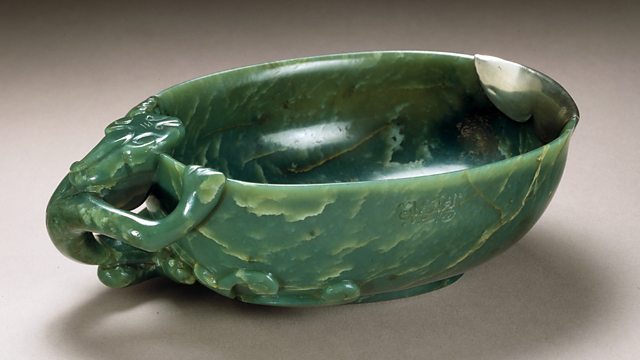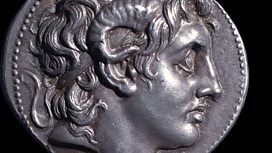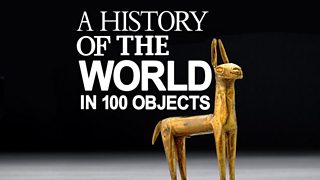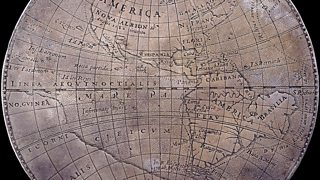Jade dragon cup
Neil MacGregor's world history explores the great empires of the world around 600 years ago. Today he examines a jade cup that belonged to a leader of the great Timurid Empire.
The history of humanity as told through one hundred objects from the British Museum in London is this week exploring powerful empires around the world in the 14th and 15th centuries. Today he is with a handsome jade cup that once belonged to one of the great leaders of the Timurid Empire - the great power that stretched across Central Asia, from Iran to parts of India. The owner of the cup was Ulugh Beg, the man who built the great observatory in his capital Samakand and who - like Galileo and Copernicus - has a crater on the moon named after him. Neil tells the story of the Timurids and charts the influences that spread along the Silk Road at this time. The Uzbek writer Hamid Ismailov and the historian Beatrice Forbes Manz describe the Timurid world and the extraordinary character of Ulugh Beg.
Producer: Anthony Denselow
Last on
![]()
More programmes from A History of the World in 100 Objects related to leaders & government
About this object
Location: Central Asia
Culture: Islam
Period: 1420-1449
Material: Jade
��
This jade cup from Central Asia would have been valued for its beauty and its protective powers. When this cup was made it was believed that jade would crack if it came into contact with poison. The cup's inscription indicates it was owned by Ulugh Beg, ruler of the Timurid Empire from 1447 to 1449. Ulugh Beg would have owned such a cup to protect himself from assassination by his rivals. However, the cup could not save him from his own son who seized power in 1449 and had Ulugh beheaded.
Who were the Timurids?
Ulugh Beg was the grandson of Timur, known in the west as Tamerlane, or 'Timur the Lame', due to a leg injury sustained in battle. Originally the ruler of a small Turkish tribe, Timur conquered the whole of Iran and Central Asia to create the Timurid Empire. After Timur's death in 1405, the empire began to disintegrate. Ulugh ruled the empire for only two years but despite the political instability it was a golden age for Iranian art. The dragon on this cup reflects Ulugh Beg's taste for Chinese decoration.
Did you know?
- Ulugh Beg was an accomplished astronomer and scientist - there is a crater on the moon bearing his name.
Local craft or luxury foreign import?
By Carol Michaelson, curator, British Museum
��
This jade cup is a bit of a mystery in that we cannot be sure where it was made or by whom.
The style is in the shape of a brush washer used by Chinese scholars and bureaucrats to wash ink off their brushes after use. The hornless dragon, which forms the handle, is in the form of a creature depicted by the Chinese in various guises from Neolithic times. We also know that in 1445 an embassy came from China bearing gifts, including jade vessels, to see Ulugh Beg.
Yet if we look at the craftsmanship of the cup it is not as well executed as we would perhaps expect a Chinese jade vessel to be. (The Chinese had been working jade for at least a few thousand years at this time). There are some early Ming vessels which are as simply made, but such jades are not what one might necessarily expect the Chinese court to send as a gift to another ruler.
There is evidence of the peoples of Central Asia working jade, probably deriving the material from the same area of what is now Xinjiang province as the Chinese. Among the fruits of the conquests of Timur, founder of the Timurid dynasty, was the forcible moving of craftsmen from cities as far apart as Delhi and Aleppo to make adornments for his capital at Samarqand in Central Asia. It is possible that some Chinese craftsmen were also inveigled or encouraged to work at the capital.
We know that Ulugh Beg, a highly-educated scholar, particularly of mathematics and astronomy, was attracted to the arts of China. He built a pavilion outside the city of Samarqand, called the Chini Khana, the walls of which were decorated with Chinese porcelains.
He obviously also had a liking for jade as he is known to have brought back a huge slab as booty after his defeat of the ruler of Moghulistan on the Ili River, 1424-5. This was worked into a gravestone commemorating his illustrious predecessor, Timur. He also built the Masjid-I muqatta in Samarqand itself which owed its name to the Chinese decorations of carved and coloured woods coverings its ceilings and walls.
We cannot be sure if Chinese craftsmen were used by Ulugh Beg in Samarqand but it is certainly possible. However the workmanship of this cup suggests perhaps the hand of a mason used to cutting large blocks of jade rather than a skilled lapidary. So perhaps it was made in imitation of a Chinese vessel presented to the Timurid court but crafted by a native Timurid workman rather than a more skilled Chinese jade worker.
And perhaps we will never know.
Protection, parties and destiny
By Hamid Ismailov, Uzbek journalist and writer
��
When I look at this object there are immediately several thoughts. One of them is the wine parties of that epoch which were held by Babur Shah and by Ulugh Beg himself. Apparently, Ulugh Beg was a ruler in whose court there were musicians, there were singers, there were wine parties: so immediately I think about those parties. On the other hand I can’t resist thinking about poisoning at that time, because many Timurids were poisoned by different adversary parties and jade is an antidote; it was considered to be an antidote. Therefore it’s in a way a protection, because whatever you drink from this jade it was considered that it could be your saviour from any poison.
Also, a third thing, they used to carry them at their belts, because apparently jade was helpful against all kind of kidney problems. In other languages it’s called nephrite because of the kidney. So apparently he was carrying this cup in his belt as well.
The last thought which this cup brings is the dynasty of the Timurids because it belonged to a dynasty of Timurids It went then to India to Shah Jahan, to Jahangir and other many other great statesman of that epoch. And finally it’s here as a fulfilled cup of destiny.
The Timurid Empire
By Beatrice Forbes Manz, Associate Professor of History, Tufts University
��
This jade cup stands for a number of things that I think are interesting about the Timurids. This was a period when Chinese influence was quite strong, in art particularly. The Chinese influence was always felt in Iran – the Silk Road has always gone through Iran – the Mongols however had intensified it very considerably. There was a tremendous amount of back and forth between Iran and China in the Mongol period. This continued under the Timurids.
The Timurid Empire comes out of the Mongol Empire which, at the time Timur rose to power (1370), was in decline but still had enormous prestige. Timur himself lived in Transoxiana, what’s now Uzbekistan – a member of the tribal aristocracy. He was really out to recreate the Mongol empire: he conquered an enormous territory. Starting fairly modestly, fairly close to where he was and then stretching out over much of the Golden Horde. He got close to Moscow at one point, conquered India, Iran, Iraq, and then near the end of his career he headed to Syria. He defeated the Mamluks, and then defeated the great Ottoman Sultan Bayezid, the Thunder bolt. That made him the most prestigious person both in the territory of the former Mongol Empire and in the central Islamic lands.
Transcript
Broadcasts
- Thu 16 Sep 2010 09:45�鶹������ҳ��� Radio 4 FM
- Thu 16 Sep 2010 19:45�鶹������ҳ��� Radio 4
- Fri 17 Sep 2010 00:30�鶹������ҳ��� Radio 4
- Thu 12 Aug 2021 13:45�鶹������ҳ��� Radio 4 FM
Featured in...
![]()
Leaders and Government—A History of the World in 100 Objects
More programmes from A History of the World in 100 Objects related to leaders & government
Podcast
-
![]()
A History of the World in 100 Objects
Director of the British Museum, Neil MacGregor, retells humanity's history through objects





